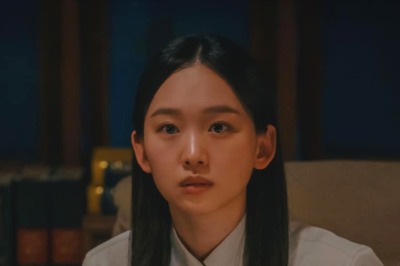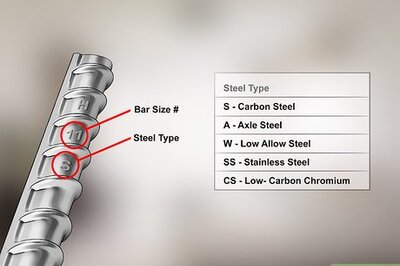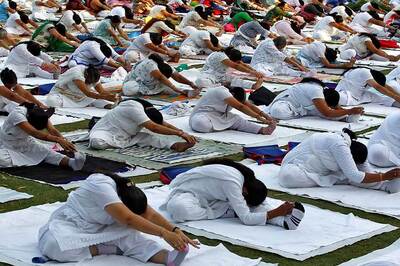
views
Best Haircuts for Thinning Hair
Buzz cut Buzz cuts are a great option for thinning hair because the barely-there stubble will help conceal spots that are thinning or balding, but you still get the confidence of having hair. Just use a 0–2 guard over your whole head so your hair is the same length all over—you still get the confidence of having hair, but it’s about as low-maintenance as it gets. There’s almost no styling required, and you won’t need to touch it up as often as you would if you shaved your head completely. This style is best for: Anyone with thinning hair or bald spots—especially if you’re looking for something easy to take care of. This style works especially well if you have an oval, oblong, or rectangular face. Try a buzz cut with a beard. A neat, cropped style like a buzz cut looks great with a well-groomed beard.
Flat top buzzcut A flat top is like a regular buzz cut, but the hair on top is cut flat with a little extra height. It looks great with or without facial hair, and it’s a low-maintenance look that doesn’t require much styling. This style is best for: Like a buzz cut, the flat top is a great option for anyone who’s dealing with thinning hair. It’s an ultra-masculine look that can elongate shorter faces—but the added volume on top can be a bit much if you have a long face.
Crew cut If you want a little more length than a buzz cut, a crew cut may be the next best thing. Crew cuts are cut extremely short on the back and sides but left a little longer from the crown forward. This can give you a little volume and texture on top, and since the hair is still pretty short all over, it’s a good way to disguise thin spots. This style is best for: This is a versatile style that’s good if your hair is thinning at the temples, at the front of your hairline, or at your crown. It works especially well to soften angular faces, like square or heart-shaped. Try a crew cut with a bald fade for a classic look that’s still a little edgy.
Regulation cut Follow the military’s lead with this cut that meets their strict regulations—short on top and shorter on the sides, with no hair touching your ears or collar. “Regulation cut” is a broad term that can include the crew cut and high and tight. If you ask for this from your barber, you’ll typically get a short cut that suits your face and hair texture. This style works best for: Anyone who wants a clean-cut look. It works especially well on oval faces. Make it yours: Let your barber or stylist know where you’d like your taper or fade to start, how long you want your hair to be, and how sharp or subtle you want the transition between the top and sides. Or, even better, ask for their advice!
Ivy league The Ivy League is a polished cut that’s usually worn parted on the side or pushed slightly back in the front. The top is left just a little longer than the back and sides, which are worn neat. The extra length and volume on the top is a great way to hide thinning hair, and the whole look is neat, professional, and entirely classic. This style is best for: The Ivy League is good for disguising thinning at the top and crown, and it can work if your hair is receding at the temples. But it needs a little length in the front, so it may not work if your hairline is receding. It can work on any face shape, especially oval and rectangular.
Business cut A business cut is worn longer on the top and short and neat at the temples and sides. It’s a professional-looking cut that can be styled pushed back or to one side, and it looks great with a neatly-trimmed beard or goatee. This style is best for: Almost anyone can rock a business cut—it’s a simple, straightforward cut that’s suitable for any setting, and it looks good even with most receding hairlines. It works for any face shape, including round, square, oblong, and oval.
Caesar The Caesar cut is a classic masculine cut where the hair is worn forward and the fringe is cut in a horizontal line across the forehead. The top is slightly textured, which can add a little volume. And it’s low-maintenance—you can add a little product for added volume and texture if you’d like, but it’s not essential. This style is best for: Because the hair is pushed forward, it’s especially good at disguising hair that’s receding at the temples and hairline. It can also help hide thinning at the top of the head. It looks great on any face shape.
French crop The French crop is a cut with short, textured layers on top and neatly-cropped hair on the sides and back. Wear the top slightly tousled—a little matte pomade or texturizing powder will help—to create volume and movement that will disguise thin spots. This style is best for: Because the layers can be cut strategically, the French crop works for most types of thinning hair. It’s also versatile enough to work with any face shape. Style tip: With a crop, you can push the hair forward, to one side, or toward the back, giving you some flexibility to cover the areas where your hair is thinnest. This style might also be called a textured crop or a layered crop.
High and tight with beard The high and tight is worn very short on the back and sides, then subtly blended into a slightly longer length on top. The top can be slightly textured to add a little volume and movement that will help make thinning areas less obvious. And while you don’t have to rock a beard with this style, it’s especially well-suited for one. This style is best for: Almost anyone with thinning hair, including moderately receded hairlines—as long as you have enough hair on top for consistent coverage. High and tight haircuts look good on oval, square, diamond, and oblong faces, but they can make round and heart-shaped faces look wider.
Short afro If your hair is naturally coily or curly, wearing it in a short afro style can give you the appearance of fullness and volume. Consider keeping the back and sides cropped a little shorter—if they’re worn long, it may be more obvious that the hair on the side of your head is fuller than the hair on top, drawing attention to the thinning areas. This style is best for: Anyone with naturally curly or coily hair that’s starting to thin at the top and crown. It may not work as well if your hairline is receding at the temples or across the front. Short afros can be shaped to flatter any face shape.
Brushed-up curls If your hair is naturally wavy or curly, use your fingers or a wide-toothed comb to style your curls straight upward. Use a little matte pomade or volumizing mousse for hold and to tame frizz, then enjoy the full volume of your natural curls. This is best for: Anyone with naturally wavy or curly hair, especially if you have a square or oval face. Keep the sides a little shorter—try to concentrate the volume on top of your head.
Short and spiky Spiking your hair can be a great way to create the illusion that your hair is thick and full, especially if you use texturizing products for hold. To make the look modern and cool, pair it with a low, mid, or high fade—the fade will add structure and style, and it may help draw the eye away from any thinning spots. This is best for: Anyone who has thinning at the temple, top, or crown. It may not work as well if you have a receding hairline. The volume and direction of the spikes can be adjusted to balance any face shape.
Short and messy Keep your hair a little longer on top, then have your stylist scissor-cut it to add messy, tousled texture. This will create the illusion that your hair is thicker and fuller on top—and if the sides are neat and short, the whole thing will look put-together. This is best for: This is a great option if your hair is receding at the temples, and it can hide moderate thinning at the top and crown. This cut can be styled so it works with any face shape.
Mid-length with texture If you’re just starting to experience some thinning, try growing your hair out to about mid-length—maybe 2–4 in (5.1–10.2 cm). Then, ask your stylist or barber to scissor-cut the top to add texture. This will help create dimension, and your hair can be directed to cover up the thinner areas. This is best for: Someone whose hair is just beginning to thin, especially if it’s limited to one area, like the temples or top.
Widow’s peak with taper If your hair is receding at the temples, it can create the look of a widow’s peak, or an M-shaped hairline. Lean into this with a cut that leaves your hair longer on top—style it pushed back or to one side—and tapered neatly on the sides. This style doesn’t necessarily disguise thinning hair. Instead, it works with what you have to create a stylish look that’s all you. This is best for: Anyone with an M-shaped hairline, especially if you have an oval or heart-shaped face. This is a distinguished but casual style that works great with or without a beard.
Brushed forward fringe Keep your hair cut close on the sides and back and leave the top front just a little longer. When you style your hair, brush the top part forward and upward for lift and volume. This is best for: Anyone who’s just starting to experience a thinning hairline or thinness at the top or crown. The hair that’s brushed forward will help emphasize the fullness in that area while detracting from thinner spots. The direction and length of the hair can be customized to suit any face shape. For even more volume, ask for a textured fringe, choppy fringe, or messy fringe. Your barber or stylist will scissor-cut the front part of your hair to add texture.
Side-swept/Comb-over If you have a receding hairline or your hair is thinning on top, wearing your hair swept to one side (often called a comb-over) can create volume and hide thinner areas. Have your barber or stylist crop your hair shorter on the sides, then cut your hair with a side part. This works especially well if your hair is wavy or curly, since you’ll have more volume, but it works with straight hair too. This style is best for: Anyone with thinning hair, as long you have enough on top for full coverage. This versatile cut can be adapted to balance any heart-shape. Style tip: Avoid gels or other styling products that will make your hair clump together, and don’t comb your hair too tightly across your head—this will only emphasize the thinning areas. Instead, use volumizing products that will create a lot of lift for better coverage.
Textured, side-swept fringe If your hair is just starting to recede at the hairline or temples, grow out a fringe (which means it’s longest at the top in the front). Ask your barber or stylist to add a little texture for movement and dimension, then wear your hair swept to the side. This can help hide thinner areas—although it can make significant thinning more obvious. Someone who’s just starting to experience hair loss in the front.
Soft shaggy cut A shaggy cut is a longer, flowing cut with lots of layers. It’s cool, modern, and a little edgy—and the layers add movement and volume that can help disguise thinning hair. This style is best for: If you’re experiencing thinning on the sides or just starting to see receding at your temples, a shaggy cut can help create a fuller look. This cut is especially suited to soften the strong angles of a square, diamond, or heart-shaped face. This style is also known as a wolf cut.
Bro flow The bro flow is a wavy style that’s longer on the top, with slightly shorter layers on the side. If your hair has a naturally wavy texture, growing it out can help add volume and draw attention away from thinning areas. Wear your hair pushed back away from your face, but with some volume at the top, and have your barber create texture with scissors. This style is best for: Anyone with wavy hair who has moderate thinning at the crown or temples. It works especially well to soften square, rectangular, or heart-shaped faces, but can be shaped to suit any face shape. Style tip: Let your hair air dry or blow dry it with a diffuser to bring out your naturally wavy texture, and use lightweight styling creams to preserve the volume in your hair.
Mop top The mop top is a casual, messy style with long layers that are worn pushed slightly forward. The layers create volume and the length helps disguise thinning areas. Use a little sea salt spray or texturizing powder to add more volume and texture, but avoid heavy styling products that will make the style look piecey and thin. This style is best for: Someone with a rectangular or oblong face—the long layers will help soften harsh edges without making the face appear too round.
Slicked back Wearing your hair slicked back can help disguise thinning spots, especially if you style it loose—not overly tight against your head. Wear the sides shorter and the front a bit longer for a look that’s modern and perfect for all ages. Curly slick backs are a great option for taming your natural curls while focusing the volume where you need it most. This style is best for: Slicked back styles are great if your hair is receding at the temples or at the crown, but it may not be best if your hairline is significantly receding in the front. Oval faces are particularly suited for a slicked-back style. How to style it: Use a brush or your fingers to direct your hair up and back while you dry it. Use products like matte styling cream that will add hold while still allowing some movement.
Slicked back with undercut A slick back with disconnected undercut is the perfect blend of retro meets edgy. The longer, slicked-back portion on top of your head will help disguise thinning, while the undercut creates a sharp contrast with the shorter sides. This style is best for: Someone who’s thinning toward their crown but still has fullness in the front. Style tip: Avoid combing your hair too tightly toward the back of your head. Not only can this emphasize thin areas, but tight slick-back styles may contribute to further hair loss.
Slicked back curls If you have naturally curly hair, grow out your curls, then brush them back. The natural volume of your curls will help make thinness look less noticeable—and it can even work with thinning that’s past the point of disguising. This style is best for: Someone with curly hair who still has some volume on top.
Long waves While shorter hair is usually the go-to for disguising thinning or balding, long hair can sometimes work, too. Grow out your hair (be sure to get regular trims to avoid split ends), and when it’s long enough, part it on the side to create the illusion of fullness. This style is best for: This works best if your thinning is concentrated on the top of your head. It may draw attention to thinning at the temples, crown, or hairline. The volume can be adjusted to flatter any face shape.
Pompadour A pompadour is worn high and pushed back, so it’s a great option for making your hair look thicker and fuller at the top. Pair it with a taper or fade on the sides for a look that’s sleek and modern, then style it up and back. This style is best for: Anyone whose hair is thinning at the top or temples. It may not work as well if your hairline has receded significantly. Pompadours can be adjusted for any face shape but work especially well on angular shapes, like square or diamond. Style tip: Use matte pomade for a more modern look that will help your hair look thicker. If your hair is curly: A curly pompadour can be a great way to take advantage of your hair’s natural volume.
Quiff A quiff is a great way to take advantage of the hair you do have to disguise spots where it’s thinning. Styling your hair upward makes your hair look full and thick, especially near the front. Quiffs look especially modern paired with a taper of fade. This style is best for: If your hair is thinning on top but still full near the hairline, a quiff is a great option for making your hair seem thicker. The height and volume of the quiff can easily be shaped to balance any face shape. Style tip: Use a round brush to move your hair up and back as you blowdry, and add products like sea salt spray or matte pomade for hold and texture.
Faux hawk You don’t have to sacrifice your edgy style just because your hair is thinning. A faux hawk adds volume at the top to hide thinning spots, and the close-cropped sides and back create contrast. This style is best for: A faux hawk is an especially good option if your hair is thinning at the sides or temples, or for minor receding at the hairline. The added height on top is especially great for round, square, and oval faces.
Clean-shaved with beard or goatee Sometimes the easiest option for dealing with hair loss is just to lean into it and shave your head. It can feel like a big step at first, but a lot of guys find that they really love it once they make the jump. Growing a beard or goatee can create a new focal point on your face, which may help make the transition easier. This style is best for: Anyone with a generally symmetrical face, or who rocks a killer beard. EXPERT TIP Courtney Foster Courtney Foster Licensed Cosmetologist Courtney Foster is a Licensed Cosmetologist, Certified Hair Loss Practitioner, and Cosmetology Educator based out of New York City. Courtney runs Courtney Foster Beauty, LLC and her work has been featured on The Wendy Williams Show, Good Morning America, The Today Show, The Late Show with David Letterman, and in East/West Magazine. She received her Cosmetology License from the State of New York after training at the Empire Beauty School - Manhattan. Courtney Foster Courtney Foster Licensed Cosmetologist When you’re bald, the focus is on your beard. Make sure your beard is lined up, shaped, and combed. If your beard isn’t well-kept, then you won’t look well-kept.
Ponytail or top knot If you like to wear your hair a little longer, consider pulling it back into a ponytail or bun. This can help hide thinning hair at the top of your head or your crown—but don’t pull your hair too tight, as it could lead to worsening hair loss. This style is best for: Someone with thinning toward the back or crown, but still has fullness in the front. If your hairline recedes significantly, a ponytail or man bun may draw attention to the fact that you’re balding. But some guys do choose to rock this look anyway. If that’s your thing, we say go for it.
Mid or high fade Fades aren’t exactly a style on their own—they refer to the way the sides and back are cut, and they can be combined with almost any other cut on this list. High fades are longer on top and get shorter starting around your temples, while mid fades start fading a little closer to your ears. From the fade down, the hair can either be left very short or fade down to bare skin. This creates an edgy look that can help draw attention away from thinning spots. High and mid fades can be combined with a variety of hairstyles. Try a high fade with a spiky top, or go with a mid fade with a Caesar cut or messy fringe. Low fades are also versatile, but they won’t create as much contrast between the top and sides of your hair, so they won’t help hide thinning hair as much. Try a high fade with a beard. Ask your stylist or barber to blend the area around your sideburns so the transition into your beard looks natural.
Taper fade A taper fade is longer on the top and shorter on the back and sides, gradually tapering to bare skin (or very short hair) closer to your ears and neckline. You can pair a taper fade with a variety of cuts to create a polished look that can draw attention away from thinning areas. For instance, you might try a taper fade with a messy fringe if your hair is full near the front, or a taper fade with a crew cut if you want to keep the top pretty short.
Hairstyles to Avoid if You Have Thinning Hair
Tight styles Wearing your hair tightly slicked back or pulled back into a tight ponytail, braid, or topknot puts pressure on your hair follicles. That can lead to something called traction alopecia—meaning they can make hair loss and thinning worse.
Overgrown styles If your hair is overgrown, it will start to look scraggly and wispy at the ends. This will only emphasize any areas that are thinning. To avoid that, see your barber or stylist every 4–6 weeks for a trim. If you’re rocking a really short style, like a buzz cut or clean shave, you may need more frequent touch-ups. If you have a longer style, you may be able to go a little longer, but avoid waiting too long, or you could suffer split ends that will lead to breakage—and even more thinning.
Comb-overs (if your hair is very thin) While a side-swept part can help disguise thinning in the early stages, it’s less effective if you’re experiencing significant hair loss on the top of your head. In that case, comb-overs can make hair loss more obvious. Instead, embrace a more natural-looking style (like a buzz cut).
Choosing Products for Thinning Hair
Use products that add texture and volume. There are tons of hair products for men that can make hair look thicker and fuller. Start with a volumizing shampoo or conditioner—although master hair stylist Christine George cautions that these “shouldn’t be used daily because they’re drying.” After you wash your hair, try products like: Texturizing powder and dry shampoo: Professional hair stylist Matt King says that these are great options for adding texture and volume to thin hair. Sea salt spray: King says that spritzing on sea salt spray before you blow dry can add lift, grit, and texture to your hair. Matte pomade: Professional hair stylist and makeup artist Janet Miranda says that matte pomades are great for adding hold or texture without “weighing down your hair or adding shine.”
Try fibers or color powder to make your hair look fuller. To disguise thinning hair, try shaking a hair fiber powder or colored powder onto your hair. These bond to your natural hair, making it look thicker and disguising your scalp. Miranda explains that “you can buy color powders and sprays in different tones to match your hair color. Then, just spray that into the areas that are balding to cover it. You can even take eyeshadow that matches your natural color and tap it onto your scalp.”
Avoid products like gel that cause your hair to clump together. Gels, waxes, and hairsprays all have stronger hold—but when it comes to thinning hair, that’s not a good thing. When your hair clumps together, it will look thinner. Even worse, this can put pressure on your hair follicles, which can make hair loss even worse.
Styling Techniques for Thin Hair
Blow-dry upwards on low heat. King says, “if you have thin or fine hair, use sea salt spray or dry shampoo when your hair is wet. Then, blow-dry your hair. That will give you more lift, volume, and grit through the end to actually hold and sustain your style.” Use the lowest heat setting on your blow dryer to avoid heat damage. High heat can lead to breakage that can make your hair look even thinner. Use a heat protectant before styling for added protection against heat damage.
Part your hair on the opposite side to add more volume. Over time, your hair starts to lie flatter in the direction you normally style it. To make your hair look fuller, try changing up the part—place the part on the opposite side if you normally side-part it, or part it on the side if you normally part it in the center.
Add highlights or lowlights for more dimension. Adding a little color to your hair—either in the form of highlights (small pieces that are dyed a lighter color than your natural hair) or lowlights (the same thing but darker than your natural color)—can create the illusion of depth and volume. That can make your hair look fuller, which can disguise thinning areas. Adding lighter pieces can lessen the contrast between your hair and scalp, especially if you have dark hair.
Keep the sides shorter. If you’re losing hair on the top of your head or at your hairline, the hair on the sides of your head will often be thicker and fuller. If the sides are left long, it can make it more obvious that your hair is thinner on top. Keeping the sides and back trimmed neatly can help create balance, enhancing the illusion that the top of your hair is fuller.
Style your hair gently and get regular haircuts. To help prevent further hair loss, avoid tight styles, and don’t pull your hair hard while you’re styling it. Also, avoid high heat that could damage your hair, and get regular trims to avoid split ends.
Factors to Consider When Choosing a Cut
Hair density and texture Master hair stylist Frankie Sanderson says that your hair texture should be a big consideration when you’re choosing a haircut—just because a style looks good on someone else doesn’t mean it will work with your hair. He adds that a good stylist will be able to help you determine whether or not a certain style is right for you. When you’re trying to choose a cut for thinning hair, think about how your hair can be pushed and styled to move areas with more volume so they cover thin spots.
Face shape Sanderson says that “it’s important to know your face shape so you can choose a flattering cut. If your face is square, for instance, you might not want to go too short with your layers. Think about how you can cut and style your hair to create a balanced face shape and emphasize the features you love.”
Styling preferences If your style is “wash and go,” you might prefer a more casual style like a buzz cut, flat top, or Caesar cut. But if you don’t mind spending a little time styling your hair each day, a cut like a pompadour, quiff, or slicked-back style might be a good option for you.
What causes thinning hair?
Genetics is one of the biggest reasons for hair loss. This type of hair loss is known as androgenic alopecia, and it can occur in both men and women. Androgenic alopecia usually worsens gradually, starting at the hairline or top of the head in men and along the crown in women.
Hormonal changes and medical conditions can cause hair loss. Sometimes hormonal changes during pregnancy or menopause can cause women to experience hair loss, and thyroid problems can lead to hair loss in men and women. Infections, certain medications, and an autoimmune condition called alopecia areata also cause thinning hair. Chemotherapy and radiation frequently lead to thinning hair.
Hair loss can be triggered by physical or emotional stress. Stress-related hair loss can sometimes seem dramatic—large clumps of hair may fall out when you’re washing, combing, or even touching your hair. Fortunately, this type of hair loss is usually not permanent. Stress to the hair follicles can also occur as a result of too-tight hairstyles. This type of hair loss is known as traction alopecia.
FAQs
Can you reverse thinning hair? If your hair loss is caused by something like medication, stress, or your diet, you may be able to talk to your doctor to make changes that will stop your hair loss. In that case, the hair should regrow after time. If you have androgenic alopecia, talk to your doctor about medications like minoxidil or finasteride, which may help slow hair loss or even regrow hair. Hair transplants are platelet-rich plasma (PRP) treatments are more in-depth approaches to reversing hair loss. In a hair transplant, hair strands are removed from areas where your hair is fuller and moved to the thin areas. For PRP treatment, your doctor will draw your blood and separate it, then inject the plasma into your scalp to encourage hair growth.
Is it better to cut your hair short if it’s thinning? Short styles are usually better at making hair loss less noticeable. However, in early stages of thinning, longer styles can help cover thin areas.


















Comments
0 comment